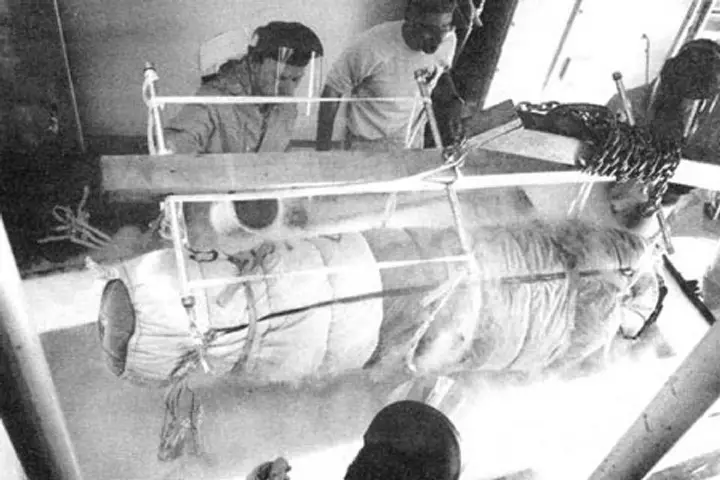 ost of you must have heard about people being cryonically or cryogenically frozen, if not in real life then at least in some science fiction movies. Truth be told there have been quite a few people that decided to be cryonically or cryogenically preserved for the future.
ost of you must have heard about people being cryonically or cryogenically frozen, if not in real life then at least in some science fiction movies. Truth be told there have been quite a few people that decided to be cryonically or cryogenically preserved for the future.
First of all, I will need to explain the difference between cryogenic and cryonic preservation. Many people think that both terms represent the same meaning, but truly they are very different. Cryogenic looks at preserving the body whilst being maintained in homeostasis at a low temperature. Cryonic means fully freezing the whole body including all organs to death in the hopes that later in life the advanced technology will be able to bring them back to life.
Asleep to the future
The first man to have done this in history was James Hiram Bedford, a psychologist who was fascinated with this idea. Bedford was born in 1893 and worked his way up to reach a very avid academic career at the University of California. He became a professor in the 1940s and at the time psychology didn’t have much to do with technology, nor did Bedford have an interest in technology, but something was about to captivate his brain.
As time went by Bedford was hit by cancer in the 1960s, which developed at reached his kidneys. In the 1960s most cancer patients were already destined to death, the technology didn’t exist to discover cancerous cells in their early stages and the treatments were still in their testing phases with a very low chance of survival.
With not much that he was able to do, Bedford tried to live the rest of his life as best as he could. In 1962 the first book about modern cryonics was published by Robert Ettinger entitled, “The Prospect of Immortality”. Of course, the since is a bit of a lie sold to those that chose to be cryonically frozen. I say this because you are clinically killed by having all of your organs stopped (frozen) in the hopes that some advanced civilization from the future will have the technology to defrost you and bring your body back to life.
The pillars of cryonic hibernation focus on freezing the cells in time at a stable temperature. Think of how we are able to preserve foods for years if kept in the freezer, well the idea is pretty much the same and it sort of stops there because science didn’t know how to bring whatever is frozen for years back to life. Of course, this is a very simplistic view as the science behind cryonic hibernation is quite complex and interesting.
Nevertheless, once Bedford had a read of the book he knew what he wanted to do with his body. He thought to himself that he does not have long to go and if there is a chance of preserving himself for future generations to share his vast knowledge within psychology, there was nothing that could have made him happier to pass away from such a disease.
The cure is in the future
Bedford knew that there was a cure for his cancer, but in the future where technology would become more advanced. That is why Bedford decided to put aside $100,000 to be donated towards research in the field of cryonics and cryogenics. In his testament, he wrote that his last wish was to have his body cryonically frozen after his death.
His hopes for a cure in the future were most probably built by Ettinger’s book which worked as a good solution for a man about to die on the brink of desperation.
Bedford passed away on the 12th of January 1967 and since then a huge war started between his wife and the organization that was carrying out research in the field of cryogenics and cryonics. This war was for $100,000 (today that would be $819,000) which Bedford gave to this organization instead of giving it to his wife and son. His wife lost the case, therefore the company was able to fulfill Bedford’s last wish of having his body cryonically frozen.

The two scientists assigned to do this procedure were Chemist Robert Prehoda and Biologist Dante Brunol. Two men who have dedicated good years of their lives to the science of cryonic hibernation. They were very happy to hear that someone was considering going through with the procedure as they were trying for years to get someone to donate their body after death for science.
The first step was to inject dimethyl sulfoxide (medical-grade antifreeze) into his bloodstream while continuing to pump oxygen through his system in order to minimize damage to his brain. His body was then placed in a capsule filled with dry ice at a temperature of -79 degrees Celcius (-174 Fahrenheit). Then the capsule would be sealed and placed in liquid nitrogen (-196 degrees Celcius/ -385 Fahrenheit).
Bradford’s body was moved multiple times after the process, however, right now it is held by an organization called Alcor Life Extension Foundation, the biggest and first company that is offering to cryonically freeze people. Right now the cost of being cryonically frozen is around $28,000 for the procedure and $50 per month to pay the rent for your capsule for as long as you wish the company to hold your capsule. The high costs and the low chance of such technology taking place in the near future are what puts people off, the reason why to this day only about 300 people have been cryonically frozen.
However, most of these people have done the procedure with another idea in mind, with the hope that in a however long time, humanity will evolve to the point where they will reach immortality and at that point there surely must exist some sort of technology to bring all of these frozen corpses back to life, that is if they make it that far and humanity does not end this world.
Avid Writer with invaluable knowledge of Humanity!
Upcoming historian with over 30 million views online.
“You make your own life.”





